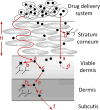Controlled release for local delivery of drugs: barriers and models
- PMID: 24801251
- PMCID: PMC4142083
- DOI: 10.1016/j.jconrel.2014.04.048
Controlled release for local delivery of drugs: barriers and models
Abstract
Controlled release systems are an effective means for local drug delivery. In local drug delivery, the major goal is to supply therapeutic levels of a drug agent at a physical site in the body for a prolonged period. A second goal is to reduce systemic toxicities, by avoiding the delivery of agents to non-target tissues remote from the site. Understanding the dynamics of drug transport in the vicinity of a local drug delivery device is helpful in achieving both of these goals. Here, we provide an overview of controlled release systems for local delivery and we review mathematical models of drug transport in tissue, which describe the local penetration of drugs into tissue and illustrate the factors - such as diffusion, convection, and elimination - that control drug dispersion and its ultimate fate. This review highlights the important role of controlled release science in development of reliable methods for local delivery, as well as the barriers to accomplishing effective delivery in the brain, blood vessels, mucosal epithelia, and the skin.
Keywords: Controlled release; Local delivery; Pharmacokinetics; Polymer systems; Wound healing.
Copyright © 2014 Elsevier B.V. All rights reserved.
Figures










Similar articles
-
Local controlled drug delivery to the brain: mathematical modeling of the underlying mass transport mechanisms.Int J Pharm. 2006 May 18;314(2):101-19. doi: 10.1016/j.ijpharm.2005.07.027. Epub 2006 May 2. Int J Pharm. 2006. PMID: 16647231 Review.
-
Controlled diffusional release of dispersed solute drugs from biodegradable implants of various geometries.Biomed Sci Instrum. 1997;33:137-42. Biomed Sci Instrum. 1997. PMID: 9731349
-
High concentrations of drug in target tissues following local controlled release are utilized for both drug distribution and biologic effect: an example with epicardial inotropic drug delivery.J Control Release. 2013 Oct 28;171(2):201-7. doi: 10.1016/j.jconrel.2013.06.038. Epub 2013 Jul 18. J Control Release. 2013. PMID: 23872515 Free PMC article.
-
Mathematical models in drug delivery: how modeling has shaped the way we design new drug delivery systems.J Control Release. 2014 Sep 28;190:75-81. doi: 10.1016/j.jconrel.2014.06.041. Epub 2014 Jul 4. J Control Release. 2014. PMID: 24998939 Review.
-
Novel oral drug formulations. Their potential in modulating adverse effects.Drug Saf. 1994 Mar;10(3):233-66. doi: 10.2165/00002018-199410030-00005. Drug Saf. 1994. PMID: 8043223 Review.
Cited by
-
A Hyaluronidase-Responsive Nanoparticle-Based Drug Delivery System for Targeting Colon Cancer Cells.Cancer Res. 2016 Dec 15;76(24):7208-7218. doi: 10.1158/0008-5472.CAN-16-1681. Epub 2016 Oct 14. Cancer Res. 2016. PMID: 27742685 Free PMC article.
-
A holistic approach to targeting disease with polymeric nanoparticles.Nat Rev Drug Discov. 2015 Apr;14(4):239-47. doi: 10.1038/nrd4503. Epub 2015 Jan 19. Nat Rev Drug Discov. 2015. PMID: 25598505 Free PMC article. Review.
-
Noninvasive characterization of in situ forming implant diffusivity using diffusion-weighted MRI.J Control Release. 2019 Sep 10;309:289-301. doi: 10.1016/j.jconrel.2019.07.019. Epub 2019 Jul 16. J Control Release. 2019. PMID: 31323243 Free PMC article.
-
Making waves: how ultrasound-targeted drug delivery is changing pharmaceutical approaches.Mater Adv. 2022 Feb 23;3(7):3023-3040. doi: 10.1039/d1ma01197a. eCollection 2022 Apr 4. Mater Adv. 2022. PMID: 35445198 Free PMC article. Review.
-
Advances in Drug Delivery via Biodegradable Ureteral Stent for the Treatment of Upper Tract Urothelial Carcinoma.Front Pharmacol. 2020 Mar 17;11:224. doi: 10.3389/fphar.2020.00224. eCollection 2020. Front Pharmacol. 2020. PMID: 32256347 Free PMC article. Review.
References
-
- Armaly MF, Rao KR. Effect of pilocarpine Ocusert with different release rates on ocular pressure. Investigative Ophthalmology. 1973;12:491–496. - PubMed
-
- Quigley HA, Pollack IP, Harbin TS. Pilocarpine Ocuserts – Long-term clinical trials and selected pharmacodynamics. Archives of Ophthalmology. 1975;93:771–775. - PubMed
-
- Zador G, Nilsson BA, Nilsson B, Sjoberg NO, Westrom L, Wiese J. Clinical experience with the uterine progesterone system (Progestasert®) Contraception. 1976;13:559–569. - PubMed
-
- Andersson K, Odlind V, Rybo G. Levonorgestrel-releasing and copper-releasing (Nova T) IUDs during five years of use: A randomized comparative trial. Contraception. 1994;49:56–72. - PubMed
-
- Lethaby AE, Cooke I, Rees M. Progesterone or progestogen-releasing intrauterine systems for heavy menstrual bleeding. Cochrane Database Syst Rev. 2005 - PubMed
Publication types
MeSH terms
Substances
Grants and funding
LinkOut - more resources
Full Text Sources
Other Literature Sources

